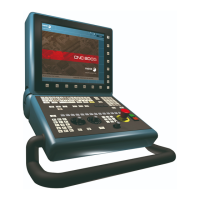Operating manual.
CNC 8060
CNC 8065
·9·
(REF: 1807)
24.4 Save the CAN configuration for the start-up test. ........................................................ 458
24.5 Report generation ........................................................................................................ 459
24.6 View the history of errors and warnings issued by the CNC........................................ 460
24.7 Generating the Fagor file for error diagnosis. .............................................................. 460
24.8 Access particular utilities of the operative system and other applications. .................. 460
24.9 Operating Terms. ......................................................................................................... 461
24.9.1 Generating the "Operating Terms” codes (only for OEM)........................................ 462
24.9.2 Enter the CNC code to activate or cancel the temporary user license..................... 464
CHAPTER 25 APPS
25.1 Send emails. ................................................................................................................ 466
25.1.1 Configure and activate the application. .................................................................... 468
25.1.2 Configuring network properties. ............................................................................... 470
CHAPTER 26 KINEMATICS CALIBRATION.
26.1 Kinematics calibration (Kinematic offsets). .................................................................. 473
26.1.1 Page 1. Data editing page........................................................................................ 473
26.1.2 Page 2. Page to display the captured position values (coordinates). ...................... 475
26.1.3 Page 3. Page to display the calculated data. ........................................................... 476
26.1.4 How to calibrate a kinematics. ................................................................................. 477
26.2 Tables to modify type 1 to 16 kinematics to vector kinematics. ................................... 478
26.2.1 Adapting a type 1 kinematics to a type 50 kinematics. ............................................ 478
26.2.2 Adapting a type 2 kinematics to a type 50 kinematics. ............................................ 479
26.2.3 Adapting a type 3 kinematics to a type 50 kinematics. ............................................ 480
26.2.4 Adapting a type 4 kinematics to a type 50 kinematics. ............................................ 481
26.2.5 Adapting a type 5 kinematics to a type 50 kinematics. ............................................ 482
26.2.6 Adapting a type 6 kinematics to a type 50 kinematics. ............................................ 483
26.2.7 Adapting a type 7 kinematics to a type 50 kinematics. ............................................ 484
26.2.8 Adapting a type 8 kinematics to a type 50 kinematics. ............................................ 485
26.2.9 Adapting a type 9 kinematics to a type 51 kinematics. ............................................ 486
26.2.10 Adapting a type 10 kinematics to a type 51 kinematics. .......................................... 487
26.2.11 Adapting a type 11 kinematics to a type 51 kinematics. .......................................... 488
26.2.12 Adapting a type 12 kinematics to a type 51 kinematics. .......................................... 489
26.2.13 Adapting a type 13 kinematics to a type 52 kinematics. .......................................... 490
26.2.14 Adapting a type 14 kinematics to a type 52 kinematics. .......................................... 492
26.2.15 Adapting a type 15 kinematics to a type 52 kinematics. .......................................... 494
26.2.16 Adapting a type 16 kinematics to a type 52 kinematics. .......................................... 496

